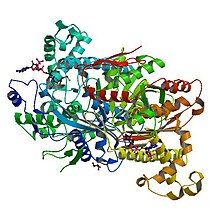Hydroxyméthylglutaryl-CoA synthase
Hydroxyméthylglutaryl-CoA synthase
| N° EC | EC |
|---|---|
| N° CAS |
| IUBMB | Entrée IUBMB |
|---|---|
| IntEnz | Vue IntEnz |
| BRENDA | Entrée BRENDA |
| KEGG | Entrée KEGG |
| MetaCyc | Voie métabolique |
| PRIAM | Profil |
| PDB | RCSB PDB PDBe PDBj PDBsum |
| GO | AmiGO / EGO |
L'hydroxyméthylglutaryl-CoA synthase (HMG-CoA synthase, HMGCS) est une transférase de la voie du mévalonate qui catalyse la réaction :
Chez les eucaryotes, il en existe deux isozymes différents, l'un cytosolique et l'autre mitochondrial (chez l'Humain, seuls 60,6 % des acides aminés sont communs à ces deux isozymes) :
- Dans le cytosol, l'HMG-CoA synthase réalise la seconde étape de la voie du mévalonate, essentielle à la biosynthèse du cholestérol et des terpénoïdes.

(en) Réactions de la voie du mévalonate et de biosynthèses liées.
- Dans les mitochondries, l'HMG-CoA synthase est responsable de la biosynthèse des corps cétoniques.

(en) Réactions de la cétogenèse.
Chez les bactéries, les précurseurs des terpénoïdes sont généralement synthétisés à travers une voie métabolique alternative, la voie du méthylérythritol phosphate ; cependant, un certain nombre d'agents infectieux à Gram positif possèdent une voie du mévalonate parallèle à celle des eucaryotes[1],[2].
Notes et références[modifier | modifier le code]
- (en) Calvin N. Steussy, Aaron D. Robison, Alison M. Tetrick, Jeffrey T. Knight, Victor W. Rodwell, Cynthia V. Stauffacher, et Autumn L. Sutherlin, « A Structural Limitation on Enzyme Activity: The Case of HMG-CoA Synthase », Biochemistry, vol. 45, no 48, , p. 14407-14414 (lire en ligne) DOI 10.1021/bi061505q
- (en) C. Nicklaus Steussy, Anthony A. Vartia, John W. Burgner, Autumn Sutherlin, Victor W. Rodwell et Cynthia V. Stauffacher, « X-ray Crystal Structures of HMG-CoA Synthase from Enterococcus faecalis and a Complex with Its Second Substrate/Inhibitor Acetoacetyl-CoA », Biochemistry, vol. 44, no 43, , p. 14256-14267 (lire en ligne) DOI 10.1021/bi051487x




